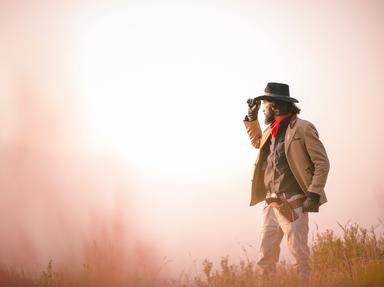Quiz Answer Key and Fun Facts
1. Which of these "state" songs became a subject of controversy when linked to the Battle of San Jacinto and a mulatto girl named Emily D. West?
"There's a yellow girl in Texas that I'm going down to see;
No other darkies know her, No darkey, only me;
She cried so when I left her That it like to broke my heart,
And if I only find her, We never more will part."
2. Which of these is a song that immortalized a path used by Texas ranchers to drive cattle north to Kansas for transport by rail?
"Come along, boys, and listen to my tale
I'll tell you of my troubles on the ___.
Come a ti yi yippee, come a ti yi yea,
Come a ti yi yippee, come a ti yi yea."
3. N. Howard "Jack" Thorp, a cattleman, collected Western music for over 20 years and in 1908 published "Songs of the Cowboys". Which of the songs below, written by him, was included in the anthology?
"___, will never wrangle more;
His days with the "remuda"-they are done.
'T was a year ago last April he joined the outfit here,
A little "Texas stray" and all alone."
4. This song was adapted from a sailor's song which opens with "O bury me not in the deep, deep sea". Which of these first appeared in print in 1932?
"___
Where coyotes howl and the wind blows free
In a narrow grave just six by three-
___"
5. Which of the songs below, also known as "The Cowboy's Lament", tells the story of a dying cowboy?
"Oh, beat the drum slowly and play the fife lowly
Play the dead march as you carry me along
Take me to the green valley, there lay the sod o'er me
For I'm a young cowboy and I know I've done wrong."
6. Which of these songs tells of a cowboy prank: putting a stranger, believed to be a greenhorn, up on a wild horse?
"We was camped on the plains at the head of the Cimmaron
When along comes a stranger and stopped to argue some,
Well he looked so very foolish when he begun to look around
For he seemed just like a greenhorn just escaped from town."
7. Though written by Ray Whitley, which of these songs is considered by many to be Gene Autry's signature song?
"I'm ___
Out where a friend is a friend
Where the longhorn cattle feed
On the lowly jimson weed
___."
8. Which of these songs is a parody of a lament about a gold miner losing his child?
"In the centre of a golden valley,
Dwelt a maiden all divine,
A pretty creature a miner's daughter
And her name was Clementine."
9. Recorded in 1924 by Bascom Lamar Lunsford, which of these folk songs is an ode to a Missouri outlaw?
"Poor ___ had a wife to mourn for his life,
Three children, they were brave;
But the dirty little coward that shot Mr. Howard
Has laid ___ ___ in his grave."
10. Selected by Kansas to be their state song in 1947, this song was originally published as a poem entitled "My Western Home". Which of the songs listed below matches both the description and the lyrics?
"Oh, give me a home where the buffalo roam,
Where the deer and the antelope play,
Where seldom is heard a discouraging word
And the sky is not clouded all day."
Source: Author
mlcmlc
This quiz was reviewed by FunTrivia editor
agony before going online.
Any errors found in FunTrivia content are routinely corrected through our feedback system.

